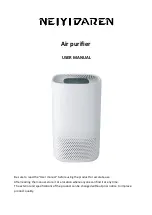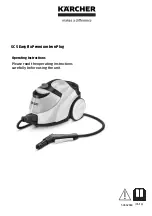
MOTOR
The GV Backpack Vacuums are equipped with the best industrial motor, the
AMETEK motor. The vacuum motors must never be used in application in
which wet or moist conditions are involved, where dry chemicals or other
volatile materials are present, or where airflow may be restricted or blocked.
Such motors are designed to permit the vacuumed air to pass over the electrical
wiring to cool it. Therefore, any liquid (including water),dry chemical, or other
foreign substance which could come in contact with electrical conductors could
cause combustion(depending on volatility) or electrical shock. Failure to
observe these precautions could result in property damage and severe personal
injury, including death in extreme cases.
THE RMO-PROTECTOR IN STRUCTIONS
This appliance is equipped with a thermo-protector, which will cut off
the circuit automatically to prevent the motor from overheating. Sufficiently
plugging the airway for an extended period will result in the vacuum shutting
off. If this occurs, press the switch to turn the vacuum to its “OFF” position and
wait about 5 minutes for the motor to cool to a safe operating temperature. Be
-sure to determine the cause of overheating and rectify the problem before using
the vacuum cleaner again, or it will continue to overheat and shut off. In some
instance the circuit is cut off because of high motor temperature caused by dust
bag clog or airway block. Please unplug the vacuum and check the inner paper
dust bag and airway .If the dust bag is too dirty and clogged, replace with a new
one. If the airway is blocked, please get rid of the blockage before reuse. The
motor can be restarted when it is cool.
ELECTRICAL
Vacuum motor operates on a standard 120 volt, 60Hz, AC circuit. Severe changes in
voltage, high or low, can cause damage to the motor and cause premature motor failure.
EXTENSION CORD
To prevent electrical damage, use the recommended 25 foot /16 gauge
extension cord (not provided). If you need to use a 100 foot cord, it must be at 14
gauges or better. Do not use cords longer than 100 feet.
PREPARATION FOR OPERATION
1.
Remove the cover (No. 34) and cover seal ring (No. 33), pull out the
cloth dust bag (No. 31). Check to
see that the filter guards (No. 1,
No. 2 and No.3) have not shifted
during shipping. (Figure A)
2.
Install an inner paper dust bag (No. 32)
inside of the outer cloth dust bag
(No. 31). At the beginning of each shift,
the bags should be checked. Empty or
replace as necessary.
NOTE: Never use a paper dust bag without the cloth dust bag.
3.
Place the cover seal ring (No. 33) on the dust bags’ opening (No. 32).
(Figure B)
4.
Replace the cover (No. 34) and clip the sunken edge of the cover tightly
by pushing downward the cover clip (No.7).
5.
Push the bent connector tube (No. 35) into the cover (No34), make sure
that it inserts into the cover (No. 34) completely and tightly (Figure C).
6.
Check the hose ends to make sure that they are tightly fixed. During use if
the hose ever comes loose from the hose end, simply screw the hose back into the
hose end.
7.
Check and make sure there is no wear on the cord. Put the power supply cord
(No.13) through the strip outside the left side of the waist belt.( Figure E).
























